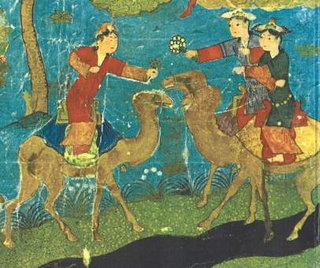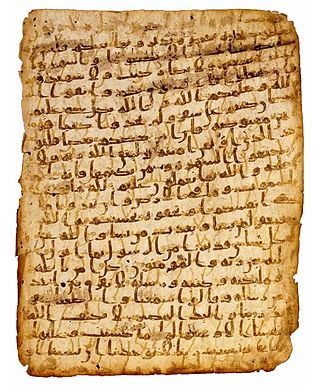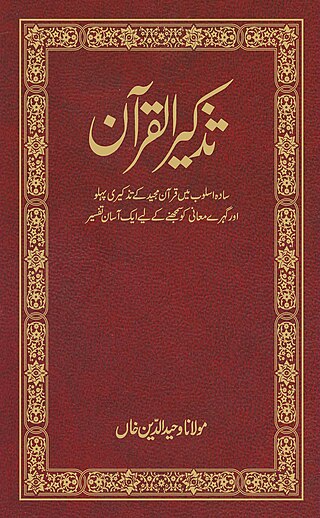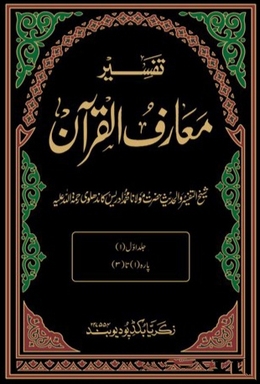
In Islam, a houri, is a woman with beautiful eyes who is described as a reward for the faithful Muslim men in paradise. The term is used four times in the Quran, where the houris are mentioned indirectly several other times,, and hadith provide a "great deal of later elaboration". Houris have been said to have "captured the imagination of Muslims and non-Muslims alike". Muslim scholars differ as to whether they refer to the believing women of this world or a separate creation, with the majority opting for the latter.

Translations of the Qurʻan are considered interpretations of the scripture of Islam in languages other than Arabic. The Qurʻan was originally written in the Arabic language and has been translated into most major African, Asian and European languages.
Tafsir refers to exegesis, usually of the Quran. An author of a tafsir is a mufassir. A Quranic tafsir attempts to provide elucidation, explanation, interpretation, context or commentary for clear understanding and conviction of God's will.

Mohammad Yunus Saleem was an Indian politician, scholar, and lawyer, who was also active in the religious field. He was also a poet who campaigned to make Urdu the second official language. He was also a devout Muslim, who regularly observed Namaz and never missed Roza. The Mohammad Yunus Saleem Memorial Education Trust was established by his son Junaid Abdul Rehman to promote the study of the Quran.

The Noble Qur'an is a translation of the Quran by Muhammad Muhsin Khan and Muhammad Taqi-ud-Din al-Hilali. It is available in many languages and is "widely and freely distributed to hajj pilgrims". It is published and printed at the King Fahd Complex for the Printing of the Holy Quran, which is said to produce ten million copies of the Quran every year.
Hamiduddin Farahi was an Indian Islamic scholar known for his work on the concept of nazm, or coherence, in the Quran. The modernist Farahi school is named after him.

Abdul Majid Daryabadi was an Islamic scholar, philosopher, writer, critic, researcher, journalist and exegete of the Quran in Indian subcontinent in the 20th century. He was as one of the most influential Indian Muslim scholar and was much concerned with modernism and comparative religions and orientalism in India. In his early life, he became sceptical of religion and called himself a "rationalist". For almost nine years, he remained away from religion but repented and became a devout Muslim. He was actively associated with the Khilafat Movement, Royal Asiatic Society, Aligarh Muslim University, Nadwatul Ulama, Darul Musannefin Shibli Academy and several other leading Islamic and literary organisations. He was disciple of Ashraf Ali Thanwi and Hussain Ahmed Madani.

Tafseer-e-Kabeer is a 10 volume Urdu exegesis of the Quran written by Mirza Bashir-ud-Din Mahmud Ahmad, the second Caliph of the Ahmadiyya Muslim Community, over a period of 20 years. It is often seen as a masterpiece by some scholars.

Islamic holy books are certain religious scriptures that are viewed by Muslims as having valid divine significance, in that they were authored by God (Allah) through a variety of prophets and messengers, including those who predate the Quran. Among the group of religious texts considered to be valid revelations, the three that are mentioned by name in the Quran are the Tawrat, received by prophets and messengers amongst the Children of Israel; the Zabur (Psalms), received by David; and the Gospel, received by Jesus. Additionally, the Quran mentions God's revealing of the Scrolls of Abraham and the Scrolls of Moses.

Tazkirul Quran is an Urdu translation and commentary on the Qur'an, written by Maulana Wahiduddin Khan, in 1985. First published in Arabic in 2008 from Cairo as al-Tadhkir al-Qawim fi Tafsir al-Quran al-Hakim, the work has also been translated into Hindi and English. The English version was published by Goodword Books in 2011 as The Quran Translation and Commentary with Parallel Arabic Text.
Tafsir Ishraq al-Ma’ani is a commentary on the Qur'an (tafsir) in the English language by Indian Islamic scholar Syed Iqbal Zaheer, who was an editor of the Bangalore-based weekly Islamic magazine Young Muslim Digest.

The Holy Quran with English translation and commentary is a 5 volume commentary of the Quran published in 1963 by the Ahmadiyya Muslim Community. It was prepared by a board of translators consisting of Maulvi Sher Ali, Mirza Bashir Ahmad and Malik Ghulam Farid.
Syed Abdul Latif was an Indian writer of English literature. He was the president of Institute of Indo-.Middle East Cultural Studies and Academy of Islamic Studies, Hyderabad and was the author of a number of books on Islamic culture and Urdu literature, among other topics. His works included The Mind Al-Qurʼan Builds, Basic Concepts of the Quran, The Opening Chapter of the Quran, and An Outline of the Cultural History of India. The Government of India awarded him Padma Bhushan, the third highest Indian civilian award, in 1970. A trust in his honor, Dr. Syed Abdul Latif's Trust for Quranic and other Cultural Studies, has published several books on Islamic culture.

Bayan Ul Quran is a three volume tafsir (exegesis) of the Quran written by Indian Islamic scholar, Ashraf Ali Thanwi (d.1943). Originally written in Urdu, it is the most prominent work of its author. The tafsīr is said to be specifically for scholars.

Tauzeeh Al-Qur'an Asan Tarjuma Quran is a three-volume tafsir (exegesis) of the Quran written by Pakistani Islamic scholar Mufti Taqi Usmani. The book was originally written in Urdu and has been translated into at least two languages, Bengali and Hindi.

Tafseer-e-Majidi or Tafsirul Quran: Translation and Commentary of the Holy Quran a complete Tafsir written by Abdul Majid Daryabadi. He was influenced by Ashraf Ali Thanwi to write a Tafsir and then he wrote this Tafsir in English first then in Urdu. The Urdu style and methodology adopted in writing this Tafsir were the same as his English Tafsir. The only difference was that this Tafsir was supposed to be comparatively more lengthy. The author himself wrote the Preface on December in 1941. The author observed that to translate the Quran is very difficult. So, he advised to the translators to follow the six main points and various subpoints to translate the Quran into English. Because he observed some problems to translate into English and he told that, there is no language in the world as well as Arabic. The Introduction was written by Abul Hasan Ali Hasani Nadwi on 16 August in 1981.

Maarif al-Quran is an 8-volume interpretation of the Quran written between 1941 and 1982. It was initiated by Idris Kandhlawi and completed by his pupil Malik Kandhlawi. Its purpose was to counter the influence of Western-oriented exegesis trends in South Asia. Idris Kandhlawi's approach to writing this tafsir was rooted in the methodology of his teacher, Ashraf Ali Thanwi's Bayan al-Quran. By following this method, he ensured a systematic and coherent presentation of the Quranic commentary, drawing inspiration from the teachings of the Salaf and the scholarly heritage of Islamic civilization. The tafsir synthesized insights and opinions from renowned commentators throughout history.












